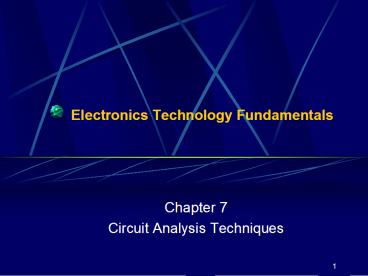Electronics Technology Fundamentals PowerPoint PPT Presentation
1 / 21
Title: Electronics Technology Fundamentals
1
Electronics Technology Fundamentals
- Chapter 7
- Circuit Analysis Techniques
2
Superposition P1
- Superposition Theorem the response of a circuit
to more than one source can be determined by
analyzing the circuits response to each source
(alone) and then combining the results
Insert Figure 7.2
3
Superposition P2
Insert Figure 7.3
4
Superposition P3
- Analyze Separately, then Combine Results
Insert Figure 7.4
5
Voltage and Current Sources P1
Insert Figure 7.7
6
Voltage and Current Sources P2
Insert Figure 7.8
7
Voltage and Current Sources P3
Insert Figure 7.9
8
Voltage and Current Sources P4
- Equivalent Voltage and Current Sources for
every voltage source, there exists an equivalent
current source, and vice versa
Insert Figure 7.11
9
Load Analysis
- A means of predicting how the circuit will
respond to a change load resistance. - Load analysis of series-parallel circuits could
be long and tedious (and prone to error). - Applying Thevenins Theorem can greatly simplify
the load analysis of complex circuits.
10
Thevenins Theorem P1
- Thevenins Theorem any resistive circuit or
network, no matter how complex, can be
represented as a voltage source in series with a
source resistance
Insert Figure 7.15
11
Thevenin Equivalent Circuit
- Produces the same output values as the original
circuit for any given value of load resistance.
12
Thevenins Theorem P2
- Thevenin Voltage (VTH) the voltage present at
the output terminals of the circuit when the load
is removed
Insert Figure 7.18
13
Thevenins Theorem P3
- Thevenin Resistance (RTH) the resistance
measured across the output terminals with the
load removed
Insert Figure 7.21
14
Applications of Thevenins Theorem P1
- Load Voltage Ranges Thevenins theorem is most
commonly used to predict the change in load
voltage that will result from a change in load
resistance - Maximum Power Transfer
- Maximum power transfer from a circuit to a
variable load occurs when the load resistance
equals the source resistance - For a series-parallel circuit, maximum power
occurs when RL RTH
15
Applications of Thevenins Theorem P3
- Multiload Circuits
Insert Figure 7.30
16
Applications of Thevenins Theorem P4
- Bridge Circuits
Insert Figure 7.32
17
Applications of Thevenins Theorem P5
- Bridge Circuits (Continued)
Insert Figure 7.33
18
Nortons Theorem P1
- Nortons Theorem any resistive circuit or
network, no matter how complex, can be
represented as a current source in parallel with
a source resistance
Insert Figure 7.34
19
Nortons Theorem P2
- Norton Current (IN) the current through the
shorted load terminals
Insert Figure 7.35
20
Nortons Theorem P3
- Norton Resistance (RN) the resistance measured
across the open load terminals (measured and
calculated exactly like RTH)
21
Nortons Theorem P4
- Norton-to-Thevenin and Thevenin-to-Norton
Conversions
Insert Figure 7.39

